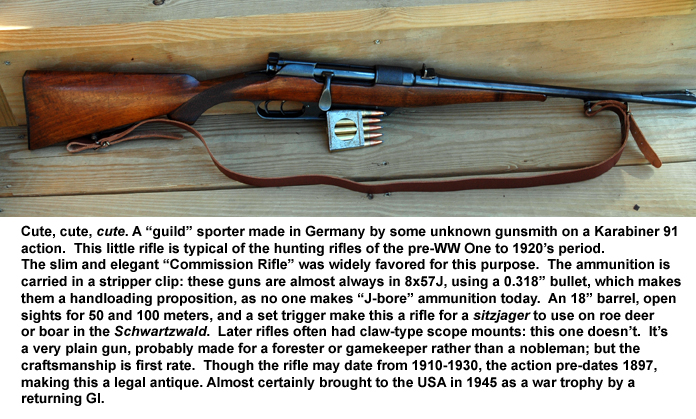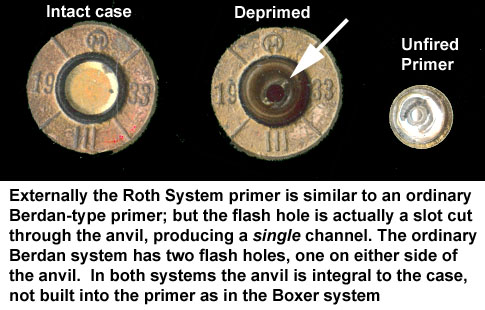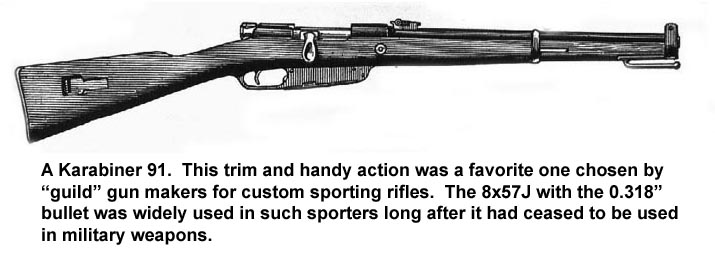AN UNUSUAL BERDAN PRIMING SYSTEM
 A couple of years ago I bought this cute little German "Guild" sporting rifle, chambered in the 8x57J caliber. This is the same as what we call the "8mm Mauser"with one teensy-weensy exception: it uses a bullet of 0.318" diameter, not the common 0.323" diameter. It's pretty much strictly a handloader's proposition, but luckily good-quality bullets in the proper diameter are readily available, and the ordinary 8x57 Mauser cases can be used, if you have a die that will squeeze down the case neck to the proper size to hold the smaller bullets.
A couple of years ago I bought this cute little German "Guild" sporting rifle, chambered in the 8x57J caliber. This is the same as what we call the "8mm Mauser"with one teensy-weensy exception: it uses a bullet of 0.318" diameter, not the common 0.323" diameter. It's pretty much strictly a handloader's proposition, but luckily good-quality bullets in the proper diameter are readily available, and the ordinary 8x57 Mauser cases can be used, if you have a die that will squeeze down the case neck to the proper size to hold the smaller bullets.
With the rifle I received a fair quantity of ammunition, in the proper en bloc clips needed. It had a headstamp I didn't recognize, a "Circle M" design; and a production date of 1933, which clearly meant it was corrosive. It was loaded with a silver-colored round-nose bullet of 0.318" diameter, but it was quite clearly military ball ammunition unsuited to hunting and I had no intention of shooting it in this gun. The clips were well worth having, though—reproductions go for about $7 each and I had ten originals—so I stashed the ammo, and loaded up some of my own. Not wanting to stress the rifle, which is well over 100 years old and built on a fairly weak Kar 91 action I bought some proper bullets from Buffalo Arms, and loaded it to about the level of a .30-30, quite adequate for my purposes.
Then a year ago I bought another German gun, this time a drilling: 16x16x8x57JR, the rimmed equivalent of the 8x57J. This too is more or less a handloader's caliber, and I had everything I needed, so I started loading that. Then I remembered I had a supply of 0.318" bullets...still in the ammo I'd got with the Guild sporter. Out came the bullet puller to break it down and salvage it for the bullets. I knew it was corrosive, it was obviously European, and the size of the primer told me it was Berdan primed, so I had no interest in the cases, nor of course the 70+ year-old powder. I pulled the bullets, and dumped the powder, short brown-colored tubes like chopped Cordite. I looked into the first case, and saw...a single flash hole. Not the two I expected to see in Berdan primed ammunition!
That rocked me back on my heels a bit: could this stuff actually be Boxer primed? It seemed unlikely that anything made in Europe in the 1930's would be, but hey, you never know. I pulled the rest of the bullets, and sure enough, all the cases had the same single flash hole. I popped out one of the primers, and it was Berdan, all right: but nothing like any other Berdan primer I'd ever seen or heard of.
 This clearly called for some investigation. I had no idea what the headstamp was, but this was obviously military-issue ammunition of some kind. The primer was sealed with a black lacquer and the FMJ bullets were much heavier than I expected. The standard military ball ammunition for the 8x57J should have been 196 grains: these were 225 grains and they were steel jacketed, strongly attracted to a magnet. Whatever it was and whoever made it, it certainly wasn't sporting ammo of any kind.
This clearly called for some investigation. I had no idea what the headstamp was, but this was obviously military-issue ammunition of some kind. The primer was sealed with a black lacquer and the FMJ bullets were much heavier than I expected. The standard military ball ammunition for the 8x57J should have been 196 grains: these were 225 grains and they were steel jacketed, strongly attracted to a magnet. Whatever it was and whoever made it, it certainly wasn't sporting ammo of any kind.
"The Internet is your friend," they say: and there is more information out there on obscure stuff than one might imagine. A bit of searching turned up the information, courtesy of the International Ammunition Association, that what I had was of Czech production (though I am still unsure what kind of firearm it was used in, perhaps a heavy machine gun) that had been loaded with the "Roth Priming System."
The Roth priming system was used by Czechoslovak Ammunition Industries in the G. Roth plant in Bratislava: the "Circle M" mark I'd been unable to identify in my reference works is that of the Bratislava plant. This priming system had an integral anvil in the case, as in all other Berdan systems: but instead of the typical two flash holes drilled on either side, a horizontal slot was milled through the anvil. This flash hole is larger than the twin ones of the typical system, and allegedly gave more certain ignition; and the size of the primer was such that it would hold more priming mix than the usual one, also to enhance reliability. I'm trying to track down the patent number, but my limited German hasn't allowed it so far.
This system was used by Czech factories from 1919 to about 1940. The state of Czechoslovakia was established in 1919 under the Treaty of Versailles, and disappeared (temporarily) after 1939 when the Nazis annexed it to the Third Reich. After that they shifted ammunition plants to making cartridges with their own two-hole Berdan system.
 So I know more than I did: but there is still one major question. Why does this ammunition have 0.318" diameter bullets? The 8x57J was superceded in 1905 in the German Army (and its allies who used the Mauser rifle) by the 0.323" diameter bullet beginning in 1905. This is referred to as the 8x57JS round (for spitzgeschoss, i.e., as pointed "spitzer" bullet).
So I know more than I did: but there is still one major question. Why does this ammunition have 0.318" diameter bullets? The 8x57J was superceded in 1905 in the German Army (and its allies who used the Mauser rifle) by the 0.323" diameter bullet beginning in 1905. This is referred to as the 8x57JS round (for spitzgeschoss, i.e., as pointed "spitzer" bullet).
By 1933 the "J" bore was obsolete and no longer in use in any military force. It was widely used in sporting rifles, but this is most emphatically not sporting ammunition, so that's out. The Czechs made Mauser rifles and issued 8x57JS ammunition, so why make the J bore bullets at all? And why are they so heavy, and steel jacketed to boot?
I'm unable to come up with a reasonable explanation. Was it made for export to some other country? If so, I can't imagine which one, as so far as I know, nobody was issuing 8x57J-bore rifles in the 1930's. The rifle that introduced the 8mm Mauser round to the world, the Gewehr 88, was originally made with a J-sized bore, but nearly all these rifles were re-barreled or re-bored to the larger size. The only thing I can think of is that somehow, somewhere, some army was still carrying original-issue Gew 88's and bought ammunition from the Czech factories. Could it have been made for China? The Chinese used a variant of the Gew 88 made in their own arsenal, and I don't know if they stuck with the smaller bullet or switched over. It certainly wasn't made for Turkey, who used the Gew 88, but who re-barreled to the 0.323" size in or before WW one. Was it made for machine guns?
If any of my readers can shed light on this very minor arms-collecting mystery, or can tell me the number of Georg Roth's patent so I can track down a copy, please send me a note!
| HUNTING | GUNS | DOGS |
| FISHING & BOATING | TRIP REPORTS | MISCELLANEOUS ESSAYS |
| CONTRIBUTIONS FROM OTHER WRITERS|
| RECIPES |POLITICS |
 A couple of years ago I bought this cute little German "Guild" sporting rifle, chambered in the 8x57J caliber. This is the same as what we call the "8mm Mauser"with one teensy-weensy exception: it uses a bullet of 0.318" diameter, not the common 0.323" diameter. It's pretty much strictly a handloader's proposition, but luckily good-quality bullets in the proper diameter are readily available, and the ordinary 8x57 Mauser cases can be used, if you have a die that will squeeze down the case neck to the proper size to hold the smaller bullets.
A couple of years ago I bought this cute little German "Guild" sporting rifle, chambered in the 8x57J caliber. This is the same as what we call the "8mm Mauser"with one teensy-weensy exception: it uses a bullet of 0.318" diameter, not the common 0.323" diameter. It's pretty much strictly a handloader's proposition, but luckily good-quality bullets in the proper diameter are readily available, and the ordinary 8x57 Mauser cases can be used, if you have a die that will squeeze down the case neck to the proper size to hold the smaller bullets.  This clearly called for some investigation. I had no idea what the headstamp was, but this was obviously military-issue ammunition of some kind. The primer was sealed with a black lacquer and the FMJ bullets were much heavier than I expected. The standard military ball ammunition for the 8x57J should have been 196 grains: these were 225 grains and they were steel jacketed, strongly attracted to a magnet. Whatever it was and whoever made it, it certainly wasn't sporting ammo of any kind.
This clearly called for some investigation. I had no idea what the headstamp was, but this was obviously military-issue ammunition of some kind. The primer was sealed with a black lacquer and the FMJ bullets were much heavier than I expected. The standard military ball ammunition for the 8x57J should have been 196 grains: these were 225 grains and they were steel jacketed, strongly attracted to a magnet. Whatever it was and whoever made it, it certainly wasn't sporting ammo of any kind. So I know more than I did: but there is still one major question. Why does this ammunition have 0.318" diameter bullets? The 8x57J was superceded in 1905 in the German Army (and its allies who used the Mauser rifle) by the 0.323" diameter bullet beginning in 1905. This is referred to as the 8x57JS round (for spitzgeschoss, i.e., as pointed "spitzer" bullet).
So I know more than I did: but there is still one major question. Why does this ammunition have 0.318" diameter bullets? The 8x57J was superceded in 1905 in the German Army (and its allies who used the Mauser rifle) by the 0.323" diameter bullet beginning in 1905. This is referred to as the 8x57JS round (for spitzgeschoss, i.e., as pointed "spitzer" bullet).